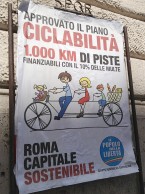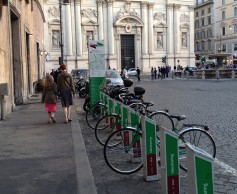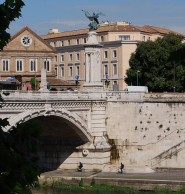 (Okay, I’m not doing that right now, but I was about two hours ago, before my siesta. Now, I’m sitting in my apartment, writing.) The pace of life in Rome is just my speed. Work in the morning, take a few hours off midday for lunch and a siesta, work a few more hours in the afternoon, then spend a long lazy evening eating, enjoying a glass of wine, and then going for a stroll—La Passeggiata. Walking is integral to the life of most cities, definitely to life in Rome.
(Okay, I’m not doing that right now, but I was about two hours ago, before my siesta. Now, I’m sitting in my apartment, writing.) The pace of life in Rome is just my speed. Work in the morning, take a few hours off midday for lunch and a siesta, work a few more hours in the afternoon, then spend a long lazy evening eating, enjoying a glass of wine, and then going for a stroll—La Passeggiata. Walking is integral to the life of most cities, definitely to life in Rome.
I’ve been here in Rome now, for just over a week. The proximity of everything makes it a true walkers’ paradise. From our apartment near the historic center, we are a 30-second walk to the bread and pizza shop, a gelato shop, and a café. Within a two-minute walk, there is at least one grocery store, a meat and cheese shop, many more cafés, and the Campo de’ Fiori, the famous outdoor fruit and vegetable market. We’ve got it all, and mostly within a two-minute walking radius. Expand that to the urban designers’ go-to five-minute walking radius, and we have just about everything we could need in life. Just how I remember it from the last time I was here, a decade ago.
 However, Rome has changed since then, too, in a way that makes me love it even more. There are bicycles, everywhere. As we wander down the curved cobblestone streets, bicyclists often wind their way past, generally slowly and courteously, just another part of the urban life. As we cross the bridge to Trastevere, bicyclists ride their way around the city down at river level. It’s a mode of transportation in the eternal city that I thought was long gone.
However, Rome has changed since then, too, in a way that makes me love it even more. There are bicycles, everywhere. As we wander down the curved cobblestone streets, bicyclists often wind their way past, generally slowly and courteously, just another part of the urban life. As we cross the bridge to Trastevere, bicyclists ride their way around the city down at river level. It’s a mode of transportation in the eternal city that I thought was long gone.
Who ever thought bikes would fit into a world of cobblestoned streets, elbow-to-elbow pedestrians, motorini, and cars?
The reality is, they blend right in. It seems to have something to do with the general process of getting through this ancient city. Everyone must always be aware and take responsibility for their potential to harm and be harmed, while also being generally courteous of others trying to make their way. Pedestrians walk confidently anywhere and everywhere, but are always on the lookout for a car trying to pass, and generally step out of the way. Bicyclists wind their way carefully among the pedestrians, moving at a slightly faster pace, but never flying through the streets (I think the cobblestones help this tendency, too). Motorini and cars also make their way through, but typically at about five miles per hour, and as far as I have seen, always aware that they are the ones crowding the street, not the other way around. In a week, I’ve only heard two car horns—both more of a courteous “toot” to raise awareness, not a blast of “get out of my way!”
 This dance of movement is what I always imagined a Dutch woonerf would be like, having not experienced it myself. But I never dreamt that the center of a major metropolitan city full of flamboyant Romans could work this way. It’s simply wonderful, and now I’m wishing I’d brought my bike. So, as soon as I can get a rental bike with a seat for my toddler, I’m planning to join in. Riding a bike in modern Rome—who would have thought?
This dance of movement is what I always imagined a Dutch woonerf would be like, having not experienced it myself. But I never dreamt that the center of a major metropolitan city full of flamboyant Romans could work this way. It’s simply wonderful, and now I’m wishing I’d brought my bike. So, as soon as I can get a rental bike with a seat for my toddler, I’m planning to join in. Riding a bike in modern Rome—who would have thought?